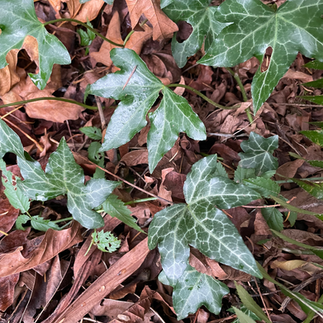Weeds Every Gardener in the Pacific Northwest Should Know - Part I
- Katie Burnham
- Nov 16, 2022
- 5 min read
Weeding a garden is probably one of the most integral management strategies for any type of garden. But before I can even discuss the importance of weeding, I want to go over the most common weeds in my garden.
My garden is located in the Pacific Northwest, near Seattle, and on the fringe of USDA Zone 8a/8b. It’s pretty rainy and dark here most the year (much of fall, all of winter, and most of spring), while the summer is rather dry, sunny, and warm. It’s never really too cold or too hot, which allows a wide variety of weeds to grow and thrive.
Here’s my disclaimer: this is not at all an exhaustive list of weeds or non-native invasive plants in Washington state, the PNW, or even my garden. But it’s just the most common weeds I pull every day from my garden and all the gardens I’ve worked in (and that’s a lot of gardens!). If you’re interested in learning more about weeds in the Pacific Northwest and Washington state, check out these websites:
1. Blackberry
Blackberries have to be the bane of my existence. Blackberries can grow up to 15 feet in a single year, are incredibly thorny, and have hard woody stems and root balls. The worst part about blackberries is that simply cutting the thorny canes down to the ground won’t kill them. To remove blackberries, you’ll have to first cut down the canes and then dig out the root ball—and I can’t guarantee that digging the root ball out will eliminate them completely, as plants can send out new canes even from a root fragment.
The two common non-native and invasive blackberries in my garden are Himalayan and Evergreen (AKA Cutleaf). Himalayan blackberry (scientific name Rubus armeniacus) has canes that are green with a red tint and are ribbed (not round); thorns tend to be about ¼ in long with round-to oblong leaflets. The Evergreen blackberry (scientific name Rubus laciniatus) has smaller canes that are redder than Himalayan and the leaflets are deeply lacerated, hence the other common name of “cut” leaf blackberry. Both blackberry species have leaflets in groups of three or five, with white to pink simple flowers.
Of course, the most distinguishing characteristic of blackberries are the sweet berry fruits that mature and ripen in August-September. The berries start out as bright red and then mature into a deep purple-black color. On hot and sunny late-summer days, the air smells sweeter from the blackberries cooking in the sun.
2. Herb Robert

Herb Robert is a weed you’re probably used to seeing and smelling, but don’t know it by its name. Herb Robert is a member of the geranium family (scientific name Geranium robertianum) and has some similarities to the common zonal geranium that gardeners love planting. Herb Robert has bright pink, purple, or light pink simple flowers, usually with five petals. Leaves are bright green and stems are red and covered with white hairs. The easiest way to identify Herb Robert is to remove or pull-up the whole plant and smell it. The smell should be pungent and strong, definitely not the same pleasant scent as a zonal or scented geranium!
Herb Robert is considered a non-native noxious weed in Washington state, though it is widespread and common in both gardens and forests. To alleviate pressure, remove all plants from your garden before Herb Robert flowers and produces seeds.
3. English Ivy
English ivy or simply just “ivy,” was originally planted as living erosion control on steep banks and hillsides and planted as an ornamental ground cover in formal English gardens. However, as with many other non-native plants in the United States, English ivy is able to outcompete nearly every other ground cover or vine and now proliferates forests and gardens without discrimination. The plant spreads vegetative from pieces of stem and roots and by seeds, (which birds love to consume). Moreover, English ivy will carpet the ground floor and then scale massive trees, engrossing trunks with large, woody vines and heavy foliage. Unchecked, English ivy has the capacity to kill mature trees by outcompeting for both light and space in the forest canopy. Unfortunately, I’ve seen this plant starting to kill off entire forests—growing faster and denser than any native plant.
English ivy is both a ground cover and a climbing vine with dark green leaves. The leaves come in a variety of shapes ranging from narrow to fat, many lobed, and single lobed. The leaf edges, however, are always smooth and sometimes leaves have white veins. I hardly ever notice when English ivy flowers in the late winter and early spring, but the berries produced are recognizable all summer long and are a deep dark purple-black.
To remove English ivy from your garden, start pulling on the above-ground vine and then continue pulling roots from below the soil. Cut climbing vines with a chainsaw or hand saw about 1-2 feet above the ground, making sure not to cut into the tree or fence. Climbing vines will show signs of death by first dropping leaves and then turning completely brown and withering. At this point, you may be able to pull the vine out of the tree.
4. Morning Glory
Morning glory is also commonly known as hedge bindweed (scientific name Calystegia sepium) and Is an herbaceous perennial vine with pretty white trumpet-shaped flowers. The leaves are heart-shaped, lime green, and look as if they spin around the vine.
Morning glory is a vigorous grower and can cover an entire fence or plant in a matter of weeks if left alone. For instance, I’ve removed morning glory from a customer’s fence completely and did my best to remove all the roots too. Two weeks later when I returned, the morning glory had already re-sprouted from a root fragment and was about 3 feet tall. This plant is extremely difficult to eradicate once established, as it reproduces vegetative from roots, rhizomes, and stem fragments in addition to sexually reproducing by seed. As a double whammy, morning glory seeds can lie dormant in the soil for 20 years!!! That’s a long time for any gardener to battle a plant. Removing plants completely and then sheet mulching with cardboard is one method I’ve used to keep morning glory from growing back and taking over gardens.
5. Stinging Nettle
Stinging nettle is the first plant on my weed list that’s actually native to the Pacific Northwest. However, stinging nettle is so prolific in my garden and such a nuisance, that I couldn’t leave it out of my top 5. There’s a ton of reasons to leave nettles growing at the forest fringes, but I personally can’t stand having it in my flower or vegetable garden beds. I’m so over-the-top sensitive to the hairs on the leaves and stems, which have chemicals that cause skin irritation, rashes, and a stinging sensation when touched. Ouch! No one likes being abused by plants in the garden!
Stinging nettles are an herbaceous shrub that can grow aggressively tall (up to 6 feet) and spread like a ground cover over large open areas. The leaves are dark green and heart-shaped with finely toothed edges. The plant produces small white, pink, or yellow blooms from June through September and then dies back to the ground in autumn. When removing nettle, make sure to wear gloves, long sleeve shirts, and pants to reduce stinging and skin irritations. Remove plants throughout the spring and summer by pulling at the base of the plant and dislodging the network of rhizomes. Make sure to pull up all the rhizomes or you'll just be making more nettle plants.
These are the top 5 weeds in my garden and plan to follow up with a Part II as soon as possible! It's Autumn here in the Pacific Northwest, so I've been wicked busy putting all my customer's gardens to bed for the winter (and I've even managy own garden--though it could use a bit more love!). Bye for now (:
































Commentaires